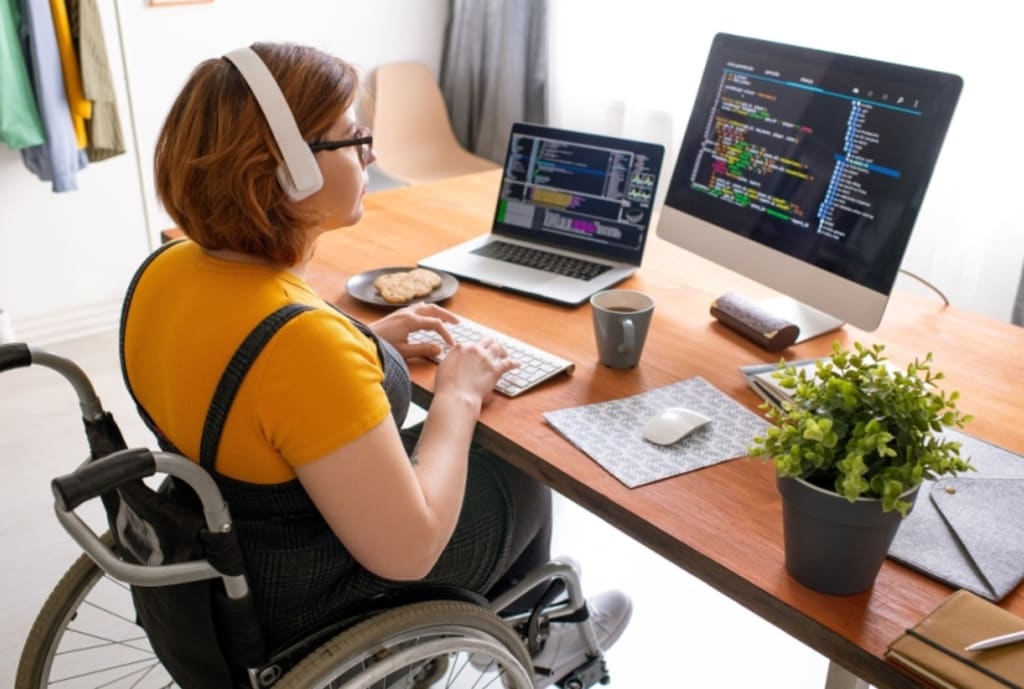Empowering Accessibility: How Big Tech Embraces Disabled Users for a Transformative Future
The Unveiling of Cutting-Edge Innovations by Tech Giants

Introduction: Paving the Way for Inclusivity
Where technological advancements dominate our daily lives, big tech companies are leveraging their expertise to champion accessibility and inclusivity for disabled individuals. By harnessing the power of artificial intelligence (AI), industry leaders like Apple and Google are rolling out groundbreaking services and features designed to transform the lives of people with disabilities. Through their innovative products and unwavering commitment, these tech giants are reshaping the landscape of assistive technology and promoting a more inclusive future.
Apple's Live Speech and Beyond
At the forefront of this accessibility revolution, Apple has unveiled a series of game-changing features. One such innovation is the Live Speech feature, introduced in May, which utilizes machine learning to recreate a user's voice. This breakthrough technology allows individuals who may be at risk of losing their ability to speak to communicate by typing messages, which are then read aloud in their natural voices. Apple's dedication to inclusivity extends beyond this remarkable feature, as they actively collaborate with organizations like Team Gleason, a charity founded by former American football player Steve Gleason, who lives with amyotrophic lateral sclerosis (ALS). By working closely with Team Gleason, Apple ensures that its products meet the specific needs of ALS patients, exemplifying their commitment to making a difference in the lives of individuals with disabilities.
Google's Lookout and Beyond
Meanwhile, Google is making significant strides in the accessibility realm with its cutting-edge technologies. One notable advancement is the upgraded version of the Lookout app, designed to assist blind and visually impaired individuals. Powered by AI, this app can now identify objects without the need for manual labeling, providing real-time descriptions and enhancing the user's understanding of their surroundings. Google's commitment to accessibility extends to its company culture, as accessibility is regarded as a fundamental aspect of every product development process. By integrating accessibility seamlessly into their products, Google is driving innovation and improving the lives of millions.
The Accessibility for All
While Apple and Google lead the charge, they are not alone in their pursuit of accessibility innovation. The increasing availability of AI models has sparked creativity among various startups and organizations. Microsoft's SeeingAI, for instance, utilizes AI to describe photos to visually impaired individuals, enabling them to access visual information that was once out of reach. Startups like Sonar Vision are developing technologies to guide visually impaired people around cities, while Equally AI leverages the power of the ChatGPT bot to enhance website accessibility. These initiatives exemplify the vast potential of AI and its ability to empower disabled individuals and foster independence.
The Intersection of Profitability and Social Responsibility
As these groundbreaking accessibility technologies continue to emerge, it is essential to strike a delicate balance between profitability and social responsibility. Manuel Pereira, representing the French Valentin Hauy association, reminds us of the potential consequences if economic considerations overshadow the goal of inclusivity. He urges companies to maintain a long-term commitment to accessibility and avoid compromising progress for short-term gains. However, Eve Andersson, Google's accessibility chief, recognizes that the growing awareness that one billion people live with disabilities has shifted the perception of accessibility as solely a moral obligation. It has become a marketplace reality, with companies recognizing the immense potential in serving this demographic and subsequently reaping the benefits.
A Future of Inclusivity and Transformation
The strides made by big tech companies like Apple and Google, along with numerous startups, are driving the accessibility revolution forward. By embracing AI and incorporating it into their products, these companies are empowering disabled individuals, promoting independence, and fostering a more inclusive society. As the transformativepotential of AI continues to unfold, the future holds promise for further advancements in accessibility technology. With each innovation, big tech companies are shaping a world where disabled users are not only included but empowered to live life to the fullest. By placing accessibility at the core of their product development strategies and collaborating with organizations and individuals directly affected by disabilities, these companies are ensuring that their advancements meet the real needs of the community they serve.
Looking ahead, it is crucial for the entire tech industry to recognize the significance of accessibility and embrace it as an integral part of their innovation process. As AI continues to evolve, it presents countless opportunities to break down barriers and create a more inclusive digital landscape. Startups and established companies alike should take inspiration from the achievements of big tech and continue pushing the boundaries of what is possible.
In this journey towards inclusivity, collaboration and feedback from disabled users are of utmost importance. By actively seeking input and engaging with the community, tech companies can ensure that their solutions address real challenges and meet diverse needs. Furthermore, the ongoing support from governments, organizations, and advocates for disability rights plays a vital role in fostering an environment where accessibility is prioritized and celebrated.
Ultimately, the embrace of disabled users by big tech represents a pivotal moment in the ongoing technological revolution. As advancements in AI-driven accessibility continue to unfold, barriers that once limited the full participation of disabled individuals in society will be dismantled. The transformative power of technology, when coupled with a steadfast commitment to inclusivity, has the potential to reshape the lives of millions, unlocking new opportunities and possibilities for disabled individuals worldwide.
In conclusion, the path towards a more inclusive future lies in the hands of big tech and the broader tech industry. By continuing to embrace disabled users, investing in accessible technology, and prioritizing the needs of all individuals, we can create a world where technology truly empowers everyone, regardless of their abilities. Together, let us forge ahead, pushing the boundaries of innovation and championing a future where no one is left behind.
With each step forward, big tech companies are not only embracing disabled users but also reshaping societal perceptions and expectations. By prioritizing accessibility in their products and services, these companies are challenging the notion that disability limits potential. Instead, they are proving that technology has the power to level the playing field and create a more equitable society.
Beyond the realm of smartphones and applications, big tech's commitment to accessibility extends to other areas as well. Companies are investing in research and development to explore advancements such as smart home devices that cater to the unique needs of disabled individuals, wearable technology that enhances mobility and independence, and innovative solutions for those with cognitive impairments. By expanding their focus, big tech is transforming the lives of a diverse range of users and solidifying their position as pioneers of inclusive technology.
However, the journey towards full accessibility is far from complete. It requires ongoing dedication, collaboration, and awareness. Big tech companies must continue to actively engage with disabled communities, seeking feedback and insights to refine their offerings. They must also foster an inclusive culture within their organizations, recognizing the value of diverse perspectives and experiences in driving innovation.
Moreover, collaboration among tech companies, startups, governments, and non-profit organizations is essential to address the multifaceted challenges faced by disabled individuals. By sharing knowledge, resources, and best practices, the collective effort can yield greater advancements in accessibility technology and create a more inclusive ecosystem.
Society as a whole also has a crucial role to play in embracing disabled users. By championing inclusivity, advocating for accessible design and infrastructure, and celebrating the achievements of disabled individuals, we can create an environment that values diversity and promotes equal opportunities for all.
As big tech continues to embrace disabled users and push the boundaries of accessibility, it sets a precedent for the broader tech industry. The impact of these efforts extends beyond the products and services themselves. It inspires a fundamental shift in mindset, fostering a culture of inclusivity and empathy that permeates all aspects of technological development.
In conclusion, the embrace of disabled users by big tech is a testament to the transformative power of technology when harnessed with the goal of inclusivity. By leveraging AI, investing in research, and collaborating with disabled communities, these companies are championing a future where technology becomes a catalyst for positive change. Through their commitment, innovation, and determination, big tech is paving the way for a more accessible and inclusive world—one where the unique abilities and contributions of all individuals are recognized, celebrated, and empowered.
About the Creator
Anthony Gatimu
Being a writer,It requires constancy, discipline, and vulnerability.But inside that weakness lies your most noteworthy strength, for it is through your weakness that you interface with perusers on a significant level.






Comments
There are no comments for this story
Be the first to respond and start the conversation.